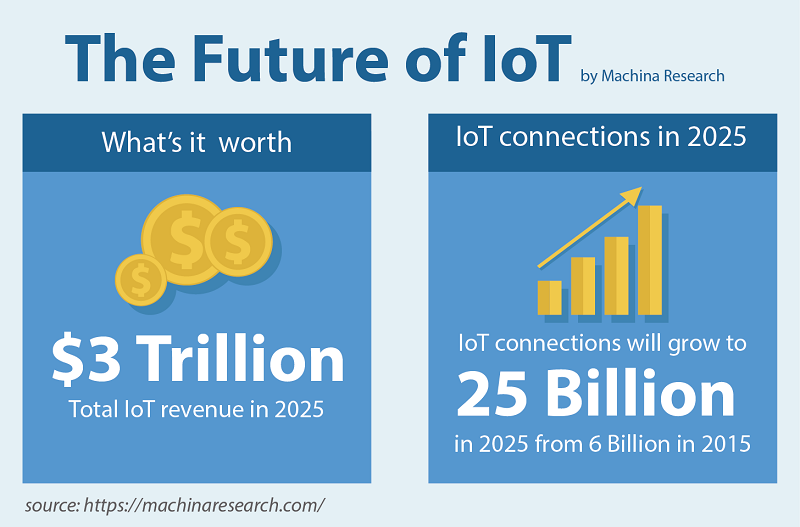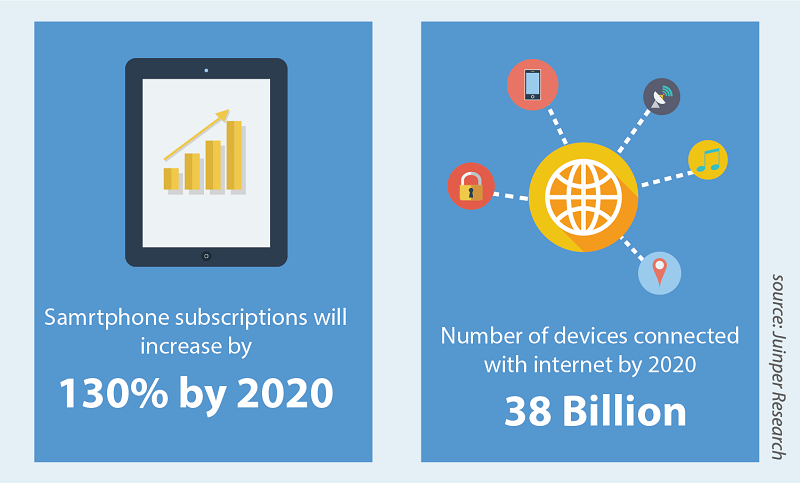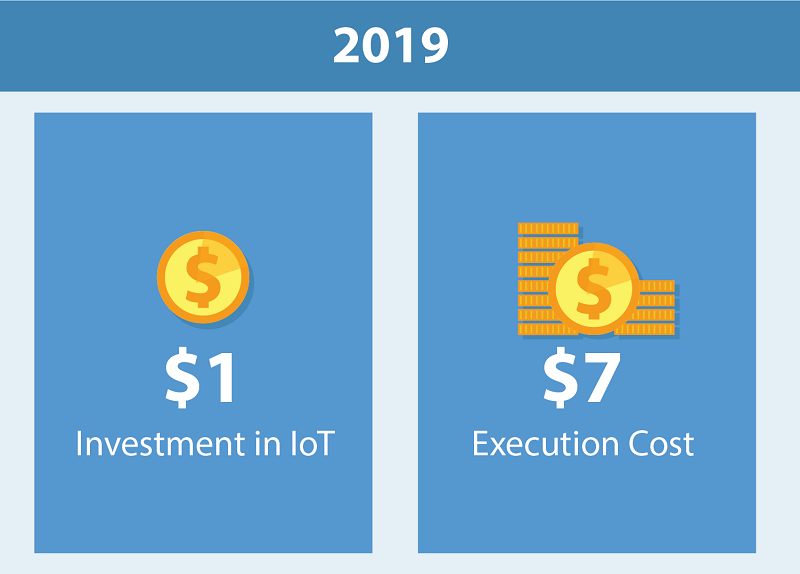White Paper| IoT and EMM
IoT and EMM – An insight into future convergence and challenges
Author: 42Gears Team
INTRODUCTION
Internet of Things (IoT) is an ever-growing network of physical devices connected to the Internet and to each other. Almost any object that has a unique identity and a sensor to transfer data over a network can be a part of IoT. This technology allows collection and exchange of data on an unprecedented scale, leading to emergence of new business opportunities. It is expected that Internet of Things market would increase to $1.5 trillion by 2020 and $3 trillion by 2025. Gartner has identified the top 10 IoT technologies for 2017 and 2018 that organizations will have to try to master if they wish to unlock the full potential of Internet of Things.

Enterprise Mobility Management (EMM) is an all-inclusive method of managing and securing use of smartphones and tablets used by employees or other users. A strong EMM strategy also helps create a more productive network for employees by providing the necessary tools to perform work-related tasks on their mobile devices.
EMM usually includes a combination of Mobile Device Management (MDM), Mobile Information Management (MIM) and Mobile Application Management (MAM). While MDM offers several features for mobile device lock down, MAM helps limit access to applications and MIM allows only certain pre-approved applications to send or receive sensitive corporate data. An EMM product can also feature an enterprise app store or any other application deployment technology.
INTERGRATION OF IoT AND EMM
While Internet of Things (IoT) and Enterprise Mobility Management (EMM) are distinct technologies, they are increasingly overlapping as more organizations adopt mobile and wearable devices within their corporate networks. As per a report by Juniper Research, over 38 billion devices are expected to get connected via internet by 2020. (Research, 2016) . It would only make sense to have a really good EMM strategy in place before trying to implement a company-wide IoT initiative. Also, an early adoption and exposure to EMM Technology can help an organization establish a comprehensive IoT Strategy.
The basic principles on which a strong Enterprise Mobility Management system runs will apply to IoT wearable and mobile devices as well. If you consider BYOD, the technology secures data regardless of where the device is being used, a point that applies to a wearable IoT device as well.


Companies starting to consider IoT as part of their endeavor to adopt new-age technology should have a strong Enterprise Mobility Management drive in place. This will help them deal with critical questions like how to manage the IoT devices connected to their network, how to secure the data transmitted between the devices, how to utilize the data collected, how to work with employee wearables, etc.
As per Gartner’s top IoT predictions for 2017, through 2019, every $1 enterprises invest in innovation will require an additional $7 in core execution. The best practice would be to test an IoT and EMM strategy on a small range of employee devices to track, observe and analyze the interactions. A minimum scale implementation will allow easier security observance through encryption and user authentication.
POSSIBLE ADVANTAGES
Converging IoT with the EMM strategy of an organization can provide rich benefits. A connected range of mobile devices, wearables, and other devices will allow employees to always stay connected, be informed and collaborate with each other easily. Sending and receiving real-time reports will become easy. The company will be able to manage devices remotely and provide real-time system updates, deal with performance issues and handle maintenance requirements.
Employees will also be able to make informed decisions based on quick access to specific data. They will get answers to questions promptly and can be more efficient and strategic in their business operations. IoT integration will also open up opportunities to tap into big data analytics on selected operations, allowing business leaders to make more informed strategies and take better decisions.
POSSIBLE COMPLICATIONS
While many organizations are looking into the business opportunities offered by the Internet of Things (IoT), there is a definite lack understanding on how to tackle the problem of security with growing number of devices getting connected to enterprise networks. As per ForeScout Technologies’ report, as of June 2016, 65% of enterprises have already deployed IoT devices. (ForeScout, 2016) But with more number of devices coming under the scanner, IT departments will have to deal with an increase in number of security threats.
Another important point of contention would be integrating proprietary applications or branded devices with new technology. It may take time and effort, not to mention implementing stringent security requirements to make the idea work. Also, any security breach can put both employee and company data at risk.
FUTURE POSSIBILITIES
There are several possibilities on how IoT solutions can improvise and enhance enterprise mobility strategies through big data collection:
1. Anticipate and Prepare for Future Contingencies & Opportunities
Customer needs and habits are ever-evolving. IoT solutions can help monitor, unlock and analyse consumption patterns and interactions to determine user behavior, all within the company’s mobile ecosystem. It will become easy to track most-used features and functions of the user, helping to understand how they utilize products. IoT enhanced Enterprise Mobility Management tool will be able to define which features, technology, interaction method and process appeals most to users. This, in turn, will allow companies to streamline and improve their platforms or networks, revamp their products or services and improve customer solutions to connect better with their patrons. Companies using IoT devices with advanced Enterprise Mobility Management solutions will be able to stay attuned to changes in their ecosystem, by capturing critical insights into customer engagement. This will further allow enterprises to quickly turn those ideas into action.
2. Refining Security and Functionality
There is always the possibility of dealing with security breach when companies work with mobility management systems. IoT solutions can help monitor and assess the company’s mobile safeguards more effectively to provide stats of possible glitches and unexpected errors that may occur. This can help organizations identify operative workarounds to potential threats and plan for possible errors.
3. Improve Reactivity
IoT-empowered Enterprise Mobility Management solutions will help company employees respond swiftly to emerging market trends and developments. Not only will they be able to spot upcoming trends based on incoming data they’ll also be better prepared to come up with quick and gainful business prototypes to work with new industry developments. The company will become better equipped to deal with changes in the market or industry landscape with adaptable business strategies.
4. Improve Productivity and Performance of Company Workforce
A strong Enterprise Mobility Management program combined with necessary IoT tools will help the company track, monitor, manage and control its workforce both on and off field more effectively. It can help boost productivity and streamline operational processes to optimize efficiency. An improved workforce performance will help reduce costs and discrepancies, increase opportunities and create competitive advantage.
LIMITATIONS
It is important to remember that, while convergence of IoT and EMM looks to be the next big thing, there are limitations as to what can be achieved in this field. IoT technology is not advanced enough to allow a single global ecosystem of things to communicate with each other seamlessly. Currently, there is no single universal application practice for IoT that can be put to use across all networking channels.
In simple words, the present state of IoT has not developed enough to allow isolated physical or digital assets to independently interact with each other. For this to happen, a single universal application layer protocol is required that will allow devices and applications to talk to each other, irrespective of their physical connection. In a corporate environment, a sub shoot of IoT known as Intranet of Things is a more likely possibility where the accessibility of connected objects is limited to the corporate network. Any future convergence possibilities between IoT and EMM will be governed by the limitations mentioned.
As Internet of Things slowly moves from vision to reality, it is vital to have the right EMM program in place to ensure effective and secure implementations of IoT tools. Adoption of IoT will exponentially grow a company’s mobility usage and that, coupled with Bring Your Own Device (BYOD) trend, will create the need for a resourceful EMM platform that is highly customizable and provides the necessary amount of automation along with ironclad security. The right EMM platform will also help in troubleshooting IoT devices, if the need arises. While some serious thought and planning will be required to decide on how to integrate an organization’s IoT needs with its EMM program, the final result can become an essential part of the business ICT solution.
REFERENCES
- ForeScout. (2016). IoT Enterprise Risk Report . ForeScout.
- Gartner. (2016). Gatner Press Release.
- Research, J. (2016). INTERNET OF THINGS’ CONNECTED DEVICES TO ALMOST TRIPLE TO OVER 38 BILLION UNITS BY 2020. Juniper Research.
- https://machinaresearch.com/
- http://themobileenterprise.asia/whitepaper/372872/iot-and-enterprise-mobility-a-bright-future/
- http://www.gartner.com/smarterwithgartner/gartner-predicts-a-virtual-world-of-exponential-change/
